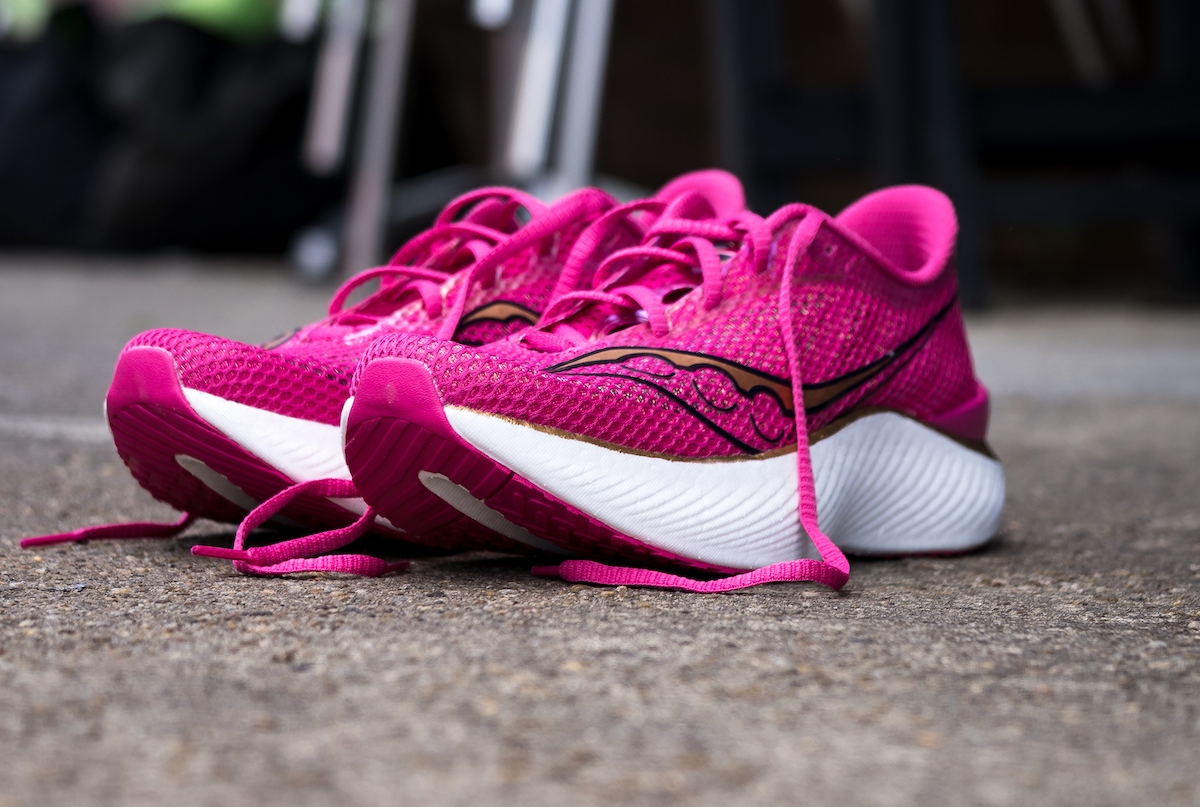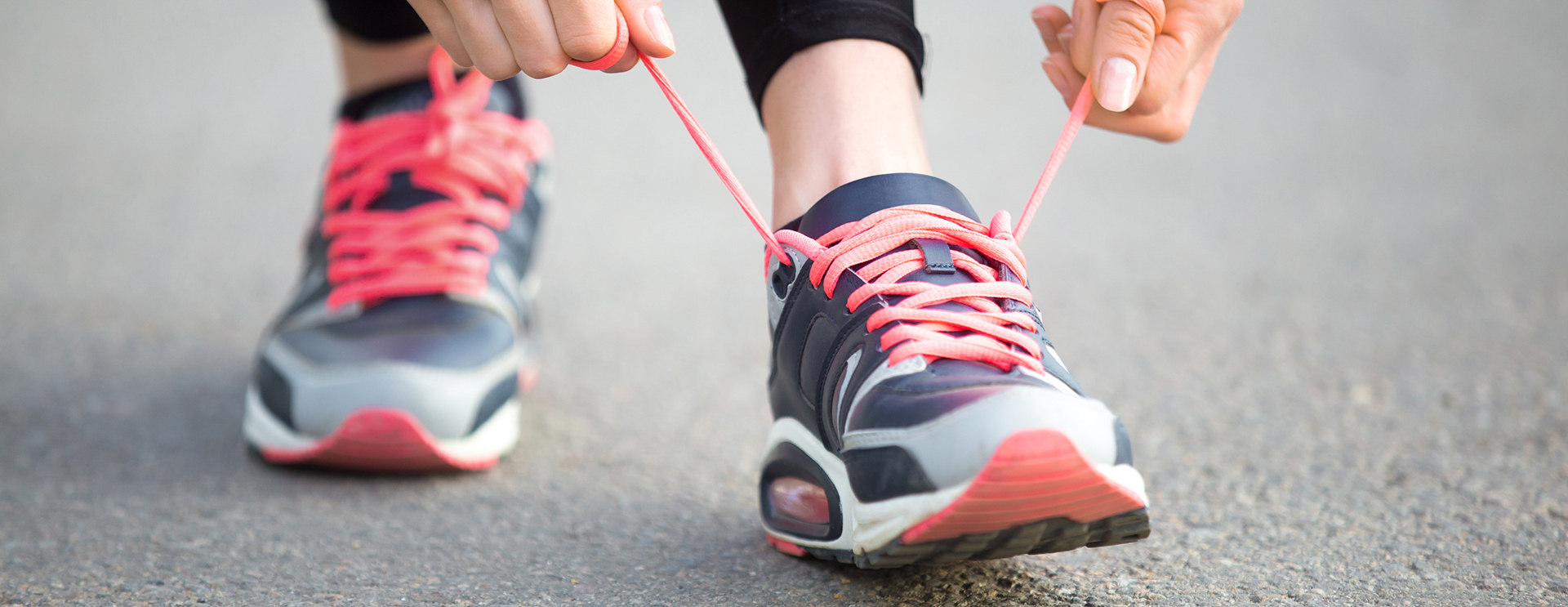

Featured
Why Do Running Shoes Have Heels
Modified: August 18, 2023
Discover the featured article on why running shoes have heels. Explore the benefits and considerations behind this essential design feature for runners.
Introduction
Running shoes are a crucial piece of equipment for athletes and fitness enthusiasts, providing the necessary support and cushioning to help maximize performance and reduce the risk of injury. One key feature that sets running shoes apart from other types of footwear is the presence of heels. But have you ever wondered why running shoes have heels? In this article, we will explore the purpose of heels in running shoes and how they contribute to your running experience.
When we think of heels, we often associate them with high fashion or formal footwear. However, the heels in running shoes serve a completely different purpose. They are specifically designed to provide a range of benefits that are essential for runners, from absorbing impact to enhancing stability and balance.
Understanding the function of heels in running shoes can help you make informed decisions when selecting the right pair for your needs. So, let’s dive into the fascinating world of running shoe design and discover why heels are an integral component of these athletic shoes.
The Purpose of Heels in Running Shoes
Running shoes are engineered to provide optimal performance and protection for runners, and the heels play a crucial role in achieving this goal. The purpose of heels in running shoes can be summarized in several key functions: impact absorption, shock attenuation, reduction of Achilles tendon strain, corrective alignment, stability, and balance.
First and foremost, the heels in running shoes are designed to absorb the impact of each step and reduce the stress on your foot and lower leg. As you run, your body weight exerts a significant force on your feet, and the heels act as a cushioning system to help dissipate that force. They are typically made with softer materials that compress upon impact, absorbing the shock and protecting your joints from potential injuries.
Additionally, the heels in running shoes are responsible for shock attenuation. When your foot lands on the ground, the impact forces generated can travel up your leg, potentially causing discomfort and fatigue. The structured design of the heels helps to dissipate these shock forces and prevent them from affecting your entire body. By absorbing and dispersing the shock, the heels play a vital role in keeping you comfortable and minimizing the risk of injuries such as stress fractures and joint pain.
The presence of heels in running shoes also helps reduce strain on the Achilles tendon, which connects the calf muscles to the heel bone. When you run, the Achilles tendon experiences significant pull, and without proper support, it can lead to discomfort and potential injuries. The elevated position of the heel in running shoes helps to alleviate strain on the Achilles tendon, allowing for a more comfortable and efficient running stride.
Moreover, the heels in running shoes contribute to corrective alignment. Each individual has a unique biomechanical structure, and running shoes are designed to accommodate these differences. The heels can be designed with varying degrees of height or angle to compensate for any imbalances in your stride and promote a more natural and efficient gait. This is especially important for runners with overpronation (inward rolling of the foot) or supination (outward rolling of the foot), as the heels can help correct these tendencies and prevent injuries that may arise from improper alignment.
Furthermore, the heels in running shoes provide stability and balance. They offer a raised platform in the rear portion of the shoe, which helps to create a more stable base for your foot. This stability allows for improved control and balance, especially during high-impact movements and sudden direction changes. Whether you’re navigating uneven terrain or sprinting on the track, the heels play a crucial role in maintaining stability and preventing potential ankle sprains or other injuries that can occur from instability.
Impact Absorption
One of the primary reasons running shoes have heels is to provide effective impact absorption. When you run, your body weight creates considerable force that is transferred through your feet and legs with each step. Without proper cushioning, this repetitive impact can lead to discomfort, fatigue, and even injuries.
The heels in running shoes are designed with materials that have shock-absorbing properties. These materials, such as foam or gel, are strategically placed in the heel area to compress upon impact and disperse the force of the foot landing. This compression helps to absorb the shock and reduce the stress on your joints, including your ankles, knees, and hips.
By absorbing the impact, the heels in running shoes contribute to a more comfortable running experience. They help to minimize the jarring and vibrations that can travel up your leg and affect your overall performance. This impact absorption is particularly beneficial when running on hard surfaces, such as pavement or concrete, where the forces on your feet are more intense.
In addition to providing comfort, effective impact absorption also plays a crucial role in injury prevention. The repetitive stress of running can lead to various overuse injuries, such as shin splints, stress fractures, and tendonitis. The shock-absorbing properties of the heels in running shoes help to reduce the mechanical stress placed on your bones, muscles, and tendons, minimizing the risk of these types of injuries.
It’s important to note that the degree of impact absorption can vary depending on the design and materials used in the heels of running shoes. Some shoes may have softer and more cushioned heels, while others may offer a firmer and more responsive feel. The choice of shoe depends on personal preferences, running style, and specific needs.
Overall, the impact absorption provided by the heels in running shoes is crucial in maintaining comfort and reducing the risk of injuries. By effectively dissipating the forces generated during running, these heels help to enhance your running experience and support your overall performance.
Shock Attenuation
Shock attenuation is another essential function of the heels in running shoes. When your foot strikes the ground while running, there is a significant amount of impact force generated. This force, if not properly managed, can lead to discomfort, fatigue, and increased risk of injury.
The heels in running shoes are designed to attenuate or decrease the intensity of the shock forces that travel up your leg upon foot contact. They act as a buffer, absorbing and dispersing the impact forces, preventing them from reaching your entire body. The materials used in the heels are carefully selected to have both cushioning and resilience properties.
Several factors contribute to the shock attenuation capabilities of the heels in running shoes. The thickness and density of the materials used play a crucial role in determining their shock-absorbing properties. Softer materials, such as foam or gel, are commonly used in the heels to provide a cushioned landing and protect your joints and bones from excessive stress.
The design and structure of the heels also impact shock attenuation. Many running shoes feature specially engineered midsole technologies, such as air pockets or specialized foam compounds, that further enhance the shock absorption capabilities of the heels. These technologies work in conjunction with the overall shoe design to provide maximum impact reduction.
Effective shock attenuation helps to minimize the vertical forces that travel through your body with each step, reducing the risk of discomfort and injury. By absorbing and dispersing the shock forces, the heels help to prevent excessive strain on your muscles, tendons, and ligaments. This is particularly important for runners who engage in high-impact activities or who run on challenging terrains.
Furthermore, the shock attenuation provided by the heels contributes to improved running efficiency. When excess shock forces are minimized, less energy is wasted in compensating for the impact, allowing you to maintain better running form and conserve energy. This can result in increased running economy and overall performance.
It’s important to note that the level of shock attenuation provided by running shoe heels can vary based on the specific shoe model and individual preferences. Some runners may prefer a more cushioned feel, while others may prefer a firmer response. Experimenting with different shoe types and technologies can help you find the right balance between cushioning and responsiveness that suits your running style and needs.
In summary, the shock attenuation provided by the heels in running shoes is a vital component in preventing discomfort and reducing the risk of injuries. By effectively absorbing and dispersing the shock forces generated during foot strike, these heels help to enhance your running experience by providing cushioning and protection for your body.
Reduction of Achilles Tendon Strain
The Achilles tendon is a strong band of tissue that connects the calf muscles to the heel bone. It plays a crucial role in supporting the foot during running and other athletic activities. However, the repetitive stress of running can put significant strain on the Achilles tendon, leading to discomfort and potential injuries.
The presence of heels in running shoes helps to reduce strain on the Achilles tendon. The elevated position of the heel in the shoe provides a slight incline and alters the angle at which the foot strikes the ground. This alteration in foot position helps to alleviate tension on the Achilles tendon, allowing for a more natural and comfortable running stride.
When you run with a flatter shoe or one with minimal heel elevation, the Achilles tendon can be exposed to greater mechanical stress. The constant pulling and stretching of the tendon during each step can lead to inflammation, stiffness, and even tendonitis if not properly managed.
By incorporating heels into running shoes, the load on the Achilles tendon is reduced. The slight rise in heel height helps to create a more favorable angle between the calf muscles and the foot, reducing the strain on the tendon. This can be particularly beneficial for runners who have a tendency to develop Achilles tendon issues or who engage in activities that place high demands on the tendon, such as sprinting or hill running.
It’s important to note that while heels in running shoes can help reduce Achilles tendon strain, other factors also contribute to the overall health of the tendon. Proper warm-up and cooldown routines, gradual increases in training intensity, and appropriate stretching and strengthening exercises for the calf muscles are all essential for maintaining the health and resilience of the Achilles tendon.
It is worth mentioning that if you have pre-existing Achilles tendon issues or are prone to developing them, seeking advice from a healthcare professional or a sports therapist is recommended. They can provide personalized guidance on footwear selection, exercises, and additional interventions to support your Achilles tendon health.
In summary, the presence of heels in running shoes helps to reduce strain on the Achilles tendon by altering foot position and creating a more favorable angle. This can lead to a more comfortable running experience and decrease the risk of Achilles tendon-related discomfort and injuries.
Corrective Alignment
Running shoes with heels are designed not only to provide comfort and cushioning but also to offer corrective alignment for runners. Each individual has a unique biomechanical structure, and slight imbalances in their running gait can lead to discomfort and increase the risk of injuries. The heels in running shoes can help address these imbalances and promote a more efficient and natural running stride.
One common biomechanical issue that runners may face is overpronation, which refers to the inward rolling of the foot when landing and pushing off. Overpronation can place excessive stress on the foot’s arch, ankle, and lower leg, resulting in discomfort and potential injuries. Running shoes with heels can be designed with corrective features to counteract overpronation.
Heels with a moderate degree of height or angling can help to control and restrict excessive inward roll and encourage a more neutral foot position. By guiding the foot towards a more aligned position, running shoes with corrective heels help to reduce the strain on the arch and provide a more stable base for the foot during each stride.
On the other hand, some runners may experience supination, which is the outward rolling of the foot during the running gait. Supination can lead to an inadequate transfer of forces and disrupt the body’s natural shock absorption mechanism. Running shoes with heels can also be designed to address this issue and promote proper alignment.
Heels with specific support zones and cushioning patterns can help absorb and distribute impact forces more effectively, allowing the foot to pronate slightly inward for a more balanced and efficient running stride. This corrective alignment reduces the risk of injuries caused by supination and promotes an optimal transfer of forces throughout the body.
It’s important to note that while running shoes with heels can provide corrective alignment, they are not a substitute for professional assessment and guidance. If you have concerns about your running gait or experience persistent discomfort, it is recommended to consult with a physical therapist, sports specialist, or footwear professional. They can perform a thorough analysis of your running mechanics and recommend the most appropriate shoe features and corrective measures tailored to your specific needs.
In summary, running shoes with heels offer corrective alignment features that can help address biomechanical imbalances. By providing support and encouraging a more neutral foot position, these shoes promote proper alignment and reduce the risk of discomfort and injuries associated with overpronation or supination.
Stability and Balance
Stability and balance are crucial factors in running, as they contribute to efficient movement, injury prevention, and overall performance. The heels in running shoes play a significant role in enhancing stability and balance during your runs.
The heels in running shoes provide a raised platform at the rear portion of the shoe, creating a more stable base for your feet. This increased height helps to improve ankle support and reduce the risk of ankle sprains or twists. The stability offered by the heels is especially beneficial when running on uneven or challenging terrains, where maintaining balance becomes more demanding.
With a stable foundation, you can maintain better control and balance during high-impact movements and sudden changes in direction. Running shoes with heels help to prevent excessive lateral movement of the foot, allowing for more efficient transfer of forces and reducing the risk of missteps or falls.
In addition to providing stability, the heels in running shoes also contribute to balance. When running, your body constantly adjusts and repositions itself to maintain equilibrium. The raised heel of running shoes increases your proprioceptive feedback, providing a sense of where your body is in relation to the ground. This enhanced feedback helps to fine-tune your balance and improve your overall running performance.
The stability and balance provided by the heels in running shoes can be further enhanced through the use of additional features. Running shoe manufacturers may incorporate technologies such as midfoot shanks or arch support to bolster stability and promote a more balanced stride.
It’s worth noting that stability and balance needs can vary among different runners based on individual biomechanics and running preferences. Some runners may benefit from shoes with more pronounced heels for added stability, while others may find that a lower heel height suits their needs better. Experimenting with different shoe models and seeking guidance from footwear professionals can help you find the optimal balance of stability and comfort for your running style.
Remember that stability and balance are not solely reliant on shoe design. Strengthening and conditioning exercises, such as core and leg workouts, can also contribute to improving your overall stability and balance. Incorporating a well-rounded training routine that includes both running and strength training can help you enhance these crucial components of your running performance.
In summary, the heels in running shoes provide stability by creating a stable and supportive base for your feet. They improve ankle support, help prevent ankle injuries, and contribute to a better sense of balance. By maximizing stability and balance, you can enjoy a more efficient and confident running experience.
Conclusion
The inclusion of heels in running shoes serves multiple purposes that enhance the overall running experience. From impact absorption and shock attenuation to reducing Achilles tendon strain, providing corrective alignment, and enhancing stability and balance, the heels play a vital role in optimizing performance and reducing the risk of injuries.
By absorbing the impact forces generated during running, the heels help protect your joints and minimize the risk of discomfort and fatigue. They provide cushioning and support that help you stay comfortable and reduce the strain on your body with each step.
Furthermore, the heels in running shoes aid in shock attenuation, dispersing the shock forces to prevent them from negatively affecting your entire body. This helps reduce the risk of injuries such as stress fractures and joint pain, promoting a healthier and more enjoyable running experience.
The presence of heels also contributes to the reduction of Achilles tendon strain. By elevating the heel, these shoes help alleviate tension on the Achilles tendon, reducing the risk of discomfort and potential injuries. This is particularly beneficial for runners with pre-existing Achilles tendon issues or those engaging in activities that place high demands on the tendon.
In addition, running shoes with heels provide corrective alignment for runners. By addressing biomechanical imbalances such as overpronation or supination, these shoes help promote a more efficient running stride and minimize the risk of discomfort and injuries associated with improper alignment.
Lastly, the heels in running shoes enhance stability and balance. They provide a stable base, improve ankle support, and increase proprioceptive feedback, allowing for better control and balance during high-impact movements and changes in direction.
When selecting running shoes, it’s important to consider the specific needs of your feet, running style, and biomechanics. Collaborating with experts in footwear and seeking guidance from professionals can help you find the right pair of running shoes with heels that provide the optimal combination of comfort, support, and performance.
In conclusion, the incorporation of heels in running shoes is not just a fashion statement but a purposeful design choice that benefits runners in various ways. With their impact absorption, shock attenuation, reduction of Achilles tendon strain, corrective alignment, and stability-enhancing properties, these heels provide the necessary support and cushioning for a smooth and injury-free running experience.









